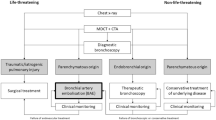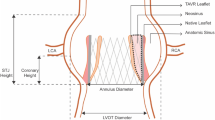Abstract
Purpose: The flow pattern in the central pulmonary arteries proximal to large pulmonary emboli was studied experimentally. The currents to which thrombolytic agents are exposed when administered via an intrapulmonary catheter were visualized in order to explain the lack of benefit of local versus systemic administration.
Methods: By illumination of suspended microspheres, the flow pattern proximal to an obstructing embolus was visualized in an in vitro pulmonary arterial flow model. In six dogs massive pulmonary embolism was created. A pigtail catheter was positioned in the pulmonary artery immediately proximal to the central edge of the occluding embolus. To allow visualization of the local flow pattern, a small amount of contrast material (4 ml) was injected through the catheter at a high flow rate (25 ml/sec). The course of the radiopaque spot that emerged from the catheter tip within 160 msec was minitored with digital subtraction angiography at a frame rate of 12.5 frames/sec. In two dogs, the study was repeated after embolus fragmentation with the same catheter position.
Results: The flow model study revealed formation of a vortex proximal to the occluding embolus. In vivo experiments showed that the radiopaque spot was whirled by the vortex proximal to the embolus and made only evanescent contact with the edge of the embolus. Regardless of the embolus location, the contrast spot was washed into the non-occluded ipsilateral and contralateral pulmonary arteries within 0.40–0.64 sec. After embolus fragmentation, the contrast spot was carried completely into the formerly occluded artery.
Conclusion: Flow studies explain why thrombolytic agents administered via a catheter positioned adjacent to the embolus may have no more effect than systemically administered agents. An enhanced local effect is precluded by the rapid washout into the non-occluded pulmonary arteries and subsequent systemic dilution. These results support the practice of direct intrathrombic injection of thrombolytics or local thrombolysis as an adjunct to embolus fragmentation.
Similar content being viewed by others
References
Barberena J (1983) Intraarterial infusion of urokinase in the treatment of acute pulmonary embolism: Preliminary observations. AJR 140:883–886
Leeper KV, Popovich J, Lesser BA, Adams D, Froehlich JW, Burke MW, Shetty PC, Thrall JH, Stein PD (1988) Treatment of acute pulmonary embolism: The use of low doses of intrapulmonary arterial streptokinase combined with full doses of systemic heparin. Chest 93:234–240
Verstraete M, Miller GAH, Bounameaux H, Charbonnier B, Colle JP, Lecorf G, Marbert GA, Mombaerts P, Olsson CG (1988) Intravenous and intrapulmonary recombinant tissue-type plasminogen activator in the treatment of acute massive pulmonary embolism. Circulation 77:353–360
Schmitz-Rode T, Adam G, Kilbinger M, Pfeffer J, Biesterfeld S, Günther RW (1996) Fragmentation of pulmonary emboli: In vivo experimental evaluation of two high-speed rotating catheters. Cardiovasc Intervent Radiol 19:165–169
Tapson VF, Gurbel PA, Witty LA, Pieper KS, Stack RS (1994)Pharmacomechanical thrombolysis of experimental pulmonary emboli. Chest 106:1558–1562
Mathias K (1992) Interventionelle Kathetertherapie bei Lungenembolie. Intensivmed 29:61–65
Schmitz-Rode T, Günther RW, Pfeffer J, Neuerburg J, Geuting B, Biesterfeld S (1995) Rotating pigtail catheter for diagnosis and fragmentation therapy of acute massive pulmonary embolism. Radiology 197:157–162
Brady AJB, Crake T, Oakley CM (1991) Percutaneous catheter fragmentation and distal dispersion of proximal pulmonary embolus. Lancet 338:1186–1189
Essop MR, Middlemost S, Skoularigis J, Sareli P (1992) Simultaneous mechanical clot fragmentation and pharmacologic thrombolysis in acute massive pulmonary embolism. Am J Cardiol 69:427–430
Sigmund M, Rubart M, Vom Dahl J, Uebis R, Hanrath P (1991) Successful treatment of massive pulmonary embolism by combined mechanical and thrombolytic therapy. J Intervent Cardiol 4:63–68
Horstkotte D, Heintzen MP, Strauer BE (1990) Kombinierte mechanische und thrombolytische Wiedereröffnung der Lungenstrombahn bei massiver Lungenembolie mit kardiogenem Schock. Intensivmed 27:124–132
Fava M, Loyola S, Flores P, Huete I (1997) Mechanical fragmentation and pharmacologic thrombolysis in massive pulmonary embolism. J Vasc Interv Radiol 8:261–266
Author information
Authors and Affiliations
Rights and permissions
About this article
Cite this article
Schmitz-Rode, T., Kilbinger, M. & Günther, R.W. Simulated flow pattern in massive pulmonary embolism: Significance for selective intrapulmonary thrombolysis. Cardiovasc Intervent Radiol 21, 199–204 (1998). https://doi.org/10.1007/s002709900244
Issue Date:
DOI: https://doi.org/10.1007/s002709900244




